How To Trim A Pine Tree Without Killing It
If you're like most homeowners, y'all know that the trees on your property should receive an occasional pruning. Withal, the task is ordinarily put off until, for the umpteenth time, you crash-land into a low-hanging branch while mowing the lawn. "That's it." you say. "Tree. your time has come."

Typically, the tree is and then attacked by a variety of tools. with limbs hacked off in a mostly random style. When a big plenty pile of branches has accumulated, the job is pronounced finished.
Unfortunately, in some cases, so is the tree.
Indiscriminate and unknowledgeable pruning can kill a tree. A dead tree is dangerous to have effectually, costly to both remove and replace, and lowers the value of your property.
But strangely enough. pruning a tree is one of the best things you tin can practice for it. Information technology'southward an important and essential step in maintaining your trees' health. The play a trick on is knowing when and where to prune.
Every time you brand a cut on a tree, you should have a reason for that cut. This article will give you those reasons by explaining the nuts of pruning, some corrective tree surgery you can do, when to prune and what tools to use.
This topic, however, is sufficiently complex that I suggest you to read any of the books in my reading list at the end of this article.
Why you lot clip
What'due south hard for most people to empathize is that pruning, properly done, strengthens rather than weakens the tree. It's 1 of the all-time things you tin can exercise for your tree.
Benefits of Pruning:
- it ensures good growth when transplanting or planting a new tree.
- it controls tree grade.
- it produces a better appearance.
- it keeps the tree healthy.
- it can rejuvenate a tree.
- it produces more and better fruit.
- it removes branches that endanger property or interfere with overhead wires or nearby structures.
There are limits, however. A mutual fault is to neglect a tree for many years. and and then in a flurry of activity (such as after reading this article), prune also severely. Nor will pruning significantly alter the shape of a mature tree, specially a conifer.
Nature's plumbing system
To prune effectively. it's essential to understand how plants respond to pruning cuts. Fig. A identifies the parts of the tree to which this article will refer.

Think of each stem (twig, co-operative or torso) as a channel — a plumbing system — carrying h2o and nutrients for growth. Past diverting this menses of h2o and nutrients (shutting off one faucet, opening some other) you're able to shape your trees. stopping growth in 1 management or speeding it in another more beneficial manner.
In pruning, the most of import parts of a tree are the buds (see inset, Fig. A). The direction a plant will abound is adamant by these buds. There are three types of buds: lateral, final, and latent.
When pruning, select the bud that will grow in the direction y'all want. Fig. B shows how growth will occur in the same co-operative pruned differently. If y'all desire more outside branches (ones that betoken away from the trunk).
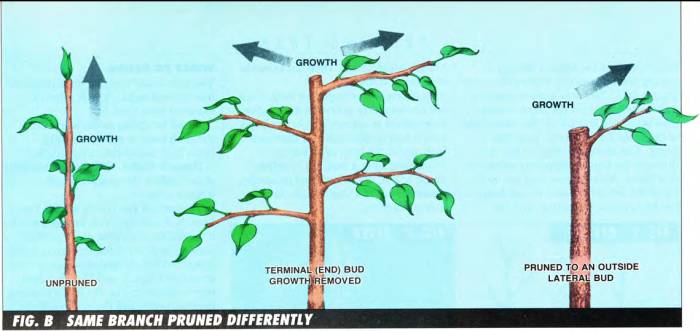
Cull buds that point to the outside of the plant. These are usually the almost desirable anyhow, considering they won't interfere with the interior of the tree.
The "final" (or stop) bud continues the outward or up growth of the co-operative. If a last bud is removed, the next closest lateral bud inherits its forcefulness and growth. In curt, removing the terminal bud causes the growth of side branches.
Buds on the sides of branches are called "lateral" buds. These buds develop into leaves and eventually into scaffold branches. If the lateral buds are removed, growth is transferred into the last bud.
Buds that lie dormant for many years are chosen "latent" buds. They are the tree'due south insurance policy against damage. They may only beginning to grow subsequently the tree has sustained damage to other branches, and it needs to reestablish the frail equilibrium of crown size to roots.
Outset them when they're immature
Pruning should begin when the tree is commencement planted.
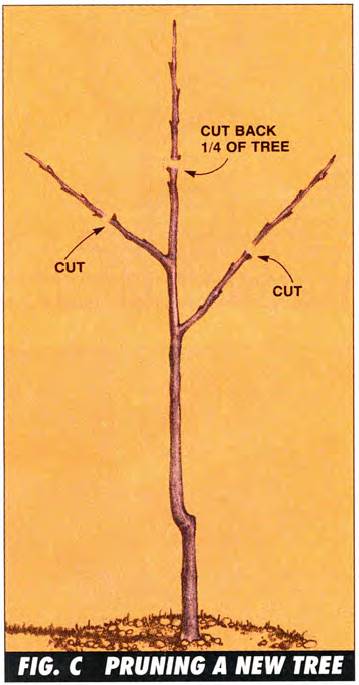
Specifically, y'all:
- Prune away broken or girdling roots back to the salubrious wood. Roots that wrap around the base of the tree are girdling roots. Eventually, a girdling root could kill the tree. Still, information technology the new tree was sold growing in a large pot or tub, y'all probably need non make any compensating root pruning.
- Remove broken or damaged branches. These branches may be diseased; removal keeps the infection from spreading to the good forest.
- Prune to compensate for the transplanting. Earlier a tree is transplanted. there is a natural, healthy balance in size between the roots and crown (the top of the tree). These two parts rely on each other for manufacturing food for the tree. In the process of transplanting, many of the roots are severed. To help restore the tree dorsum to its balanced state, parts of the crown should be pruned. A rule of thumb is to clip the new tree back by i-fourth. First. identity the leader (meet Fig. A) you want to preserve, and then prune dorsum the leader and lateral branches past about i-fourth (Information technology the planted tree is 4 ft. tall, this would mean cutting away about 12 in. from other branches.) Fig. C shows what I mean.
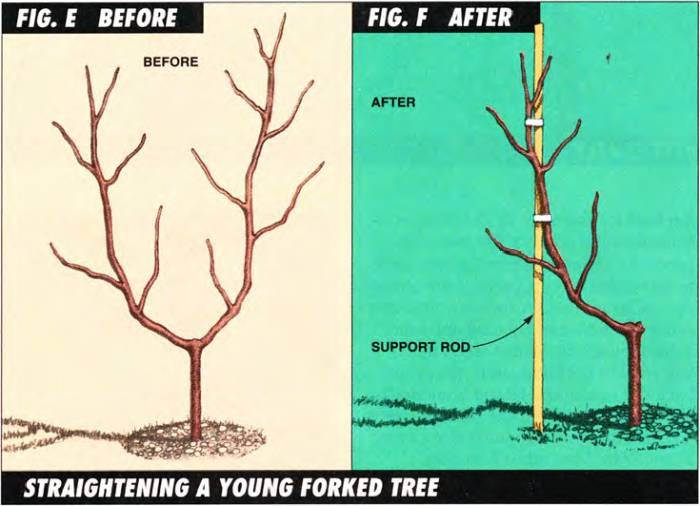
Your goal in the tree's first year is to make certain information technology survives the transplanting, not to preserve every foliage and skinny co-operative. Prune in guild to constitute the strong central leader you desire, simply as well be a bit cautious. You don't want so many wounds that the tree can't heal and grow.
How to clip
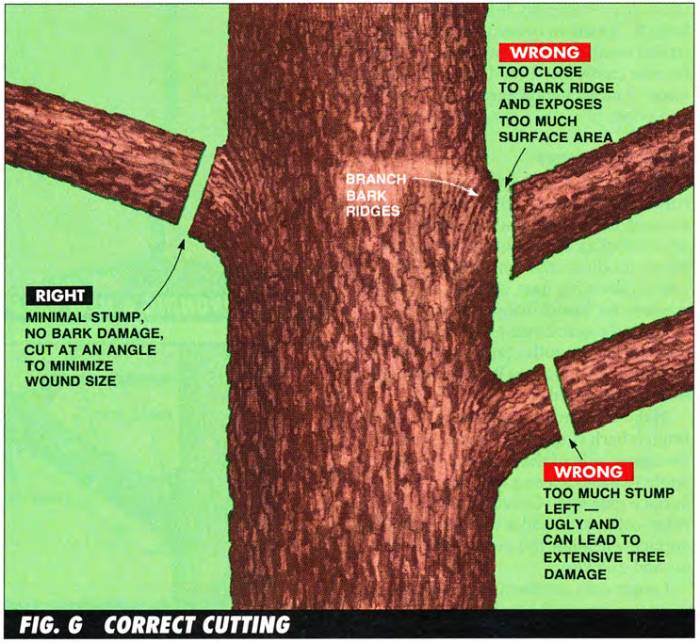
Outset, study Fig. G to larn the correct cutting techniques:
- preventing harm to the bark and bark ridges.
- leaving a make clean. slightly angled cut, which produces the smallest wound.
- avoiding long stumps, which are avenues fdr insect infestation and rot
Wound closure comes fastest when the cuts are smoothen. So keep your tools sharpened and so that you'll become a clean cut without crude edges.
Make cuts adjacent to, only not into, the co-operative bark ridge, which is located on the upper side of the branch. Cut at an angle to avoid leaving too much cut surface exposed. Leaving this bawl ridge collar area and a smaller exposed surface volition allow the cutting to heal healthier and quicker.

Larger cuts, as when thinning, crave two cuts to be made prior to the last cut (run across Fig. D). This eliminates the problem of the co-operative ripping or trigger-happy the bark on the underside as the branch falls. You may want to attach a rope to aid support the large co-operative, then make the kickoff cut on the underside of the branch about 12 in. from the trunk. Cut about one-3rd of the way through the branch, stopping before the saw binds. Make the second cut on the height of the branch near 1 in. out from the get-go cut. Keep cut until the co-operative breaks free. So cutaway the remaining stump.
In shortening in co-operative or twig, cutting it back to an existing co-operative that you've determined is appropriate, or back to a lateral bud or dormant bud (dormant buds are at the base of all leaves). When cutting to a bud, cut to within nigh i/4 in. of the bud, and as always, make the cut at a slight angle for quicker healing.
What to prune
You now know why you're pruning and how to exercise it right. Now it'south fourth dimension to examine your copse for:
- Dead or dying branches. Cut them off back to another healthy branch, or back to the principal torso.
- Branch stubs. Remove all also-long stubs dorsum to the nearest healthy branch or trunk.
- To correct the tree's shape (see Figs. E, F, and G). With younger copse, it'southward possible to do a chip of corrective surgery to foreclose the tree from developing 2 widely spaced, weak, forked branches (Figs. E and F). The ideal tree is shown in Fig. H. It has a strong central leader, and the scaffold limbs are spaced along the trunk with no 2 of them directly above and shading another branch.
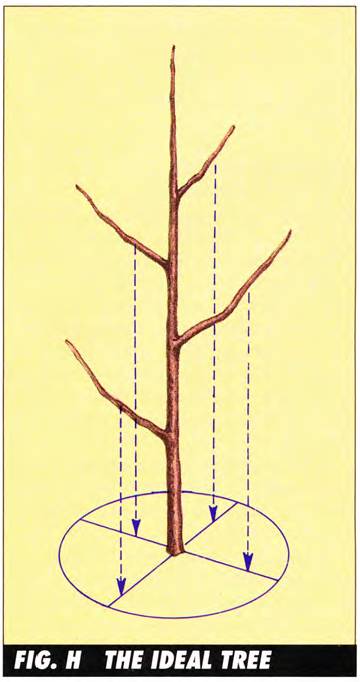
- Branches growing also close together. As well many branches likewise close together stunt the tree's growth and spoil its appearance. Correcting the situation is referred to as thinning, and since y'all're removing whole branches, refer to Fig. D for the right, three-step technique.
Thinning opens up the tree to allow in the air, low-cal and rain necessary for the leaves on the inside and the lower portions of the plant to grow properly. Thinning likewise reduces the area where snow tin can build up and break limbs. - Rubbing branches. Remove any branches that are rubbing against each other. These branches create an open wound where insects tin enter and disease tin can beginning. If untreated, a large portion of the tree tin be lost.
- Remove suckers and water sprouts (see Fig. A). Suckers are the ones at the base and trunk of the tree: water sprouts grow vertical to the trunk. They're unattractive, and they weaken the tree.
- Weak crutches (run across Fig. J). Remove branches that have weak or nary row-angle (less than about thirty degrees) crotches. Weak crotch branches are the most likely to tear away, damaging the bark and nearby branches.
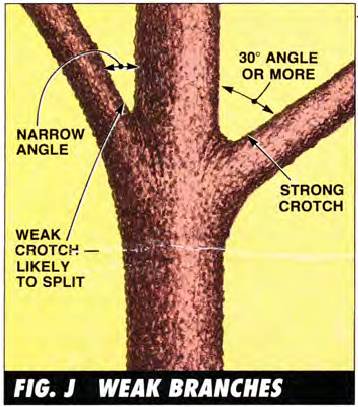
- Dangerous branches. Prune to protect people and property. Eliminate branches that are, or may be, on their way to interfering with overhead power lines; weak branches that overhang play areas, houses, or anyplace frequented by people; and low branches that brand the tree climbable, attracting kids.
How exercise I prune conifers?
Trimming conifers, such every bit pine, juniper, and spruce, leaves a lot of people cold. They'll blithely prune a maple or oak, merely sidestep a conifer because they can't figure out what to cutting.
There'southward an important stardom that has to exist fabricated when dealing with conifers. With conifers you lot must both prune and shear. Pruning controls the tree's shape and grade; shearing controls the new growth. Pruning, therefore, is removal of found pans that grew prior to the electric current season; shearing is the removal of a portion of the current season's growth,
Pruning a conifer should be confined to expressionless or cleaved branches. or limbs that are interfering with buildings, power lines or such.

Shearing a conifer is done while the new needles (referred to as "candles") are about three-quarters grown and earlier this new growth has hardened and become woody, Fig. K shows the lighter green of the new growth candles — what you lot'd shear — Compared to the darker color of the older growth.
A conifer'due south new growth should be sheared just after information technology is completed, commonly in belatedly spring or very early on summer (run across Fig. K). Usually the new growth is a lighter shade of light-green than the previous growth, and is situated at the end of the branch. Shearing off almost 1-tertiary of the new growth each year will keep the conifers growing slowly and within their intended space. Shear when the new growth is still soft. If sheared after the new growth has hardened, new buds won't form and the tips become expressionless twigs.
Shear in the evening, after the tree has been watered, using sharp shears, to help avoid the problem of needle burn (also called "shear burn"), which occurs when a too-dry out conifer is pruned.
How exercise I prune fruit copse?
Fruit copse are "working copse," so to speak, and your approach to them must be unlike. Fruit-bearing trees won't e'er have a strong central leader as preferred for near other trees. In fact, commercial growers prune their orchards in a variety of styles in order to maximize fruit production.
Strong scaffold branches should be the primary result of pruning. Keep the tree'southward branch construction fairly open and then that light and air can reach all parts. This prevents diseases and too preserves the fruiting power of lower limbs. The crowns of fruit trees are kept low to go far easier for pruning, spraying, and harvesting.
Each fruit tree type has different requirements. Please refer to any of the books in the "Additional Reading" listing at the end.
When to prune
Okay, y'all now know the why, the how, and the what. You're all primed to make life meliorate for every tree in your neighborhood. Merely concur on. the time may not be right.
The consensus is that the all-time time to prune living branches (dead and dying branches can be pruned anytime) is late in the dormant season (late winter), or very early in the leap prior to the showtime of growth.
Technically, most trees can exist pruned at any time, but some trees are more susceptible to disease and infestation if pruned during the summertime months. For case, elms and oaks are best pruned during December, January or February to reduce the run a risk of Dutch elm illness and oak wilt developing. By pruning during the colder months, wounds can heal before the hot and boiling periods provide a starting point for fungal growth.
Some copse bleed. This gratuitous-flowing sap escapes after pruning or when branch harm occurs. It may look bad, but information technology usually causes no harm to the plant, every bit long every bit information technology doesn't attract insects. These types of copse are best pruned during the fallow period.
Water sprouts and weak branches tin exist removed at whatsoever time during the summertime months. Whatsoever other pruning during the summer is more often than not not recommended, except with newly planted trees.
Treating the wound
Reverse to before beliefs, tree paint and wound dressings don't practise whatever good. The US Department of Agriculture's Forestry Service specifically advises against their use because numerous studies accept shown that they don't stop decay or prevent rot. Trees accept been healing their ain wounds for millions of years, and at that place'due south no reason to interfere with this natural process.
The right tools make all the difference

Second just to misunderstanding the how-to at tree pruning, is the defoliation nigh what tools to apply. Too many people figure that "forest is wood" and starting time pruning with either a roaring chain saw or a Carpenter's saw. Or worse.
The results won't be satisfactory, and you lot'll probable damage the tree to boot. Using the right tools lets you make the cuts described in this story, and also reduces the level of try. A small-scale investment (perhaps no more than $fourscore) in shears and pruning saw, and rental as necessary for other tools, will allow you properly maintain your trees.
When pruning small trees, the unmarried well-nigh important slice at equipment is a pair of skilful-quality pruning shears ($25 to $50). Using this tool early in a tree'southward life will greatly reduce the amount at corrective pruning that the tree will require as it matures. With the shears or a scissors-type manus pruner, you'll exist able to cut very close to the body. Position the thin blade of the shear on the trunk side to go on the resulting stub as short as possible. Shears are designed to cut branches up to one/2 in. thick.
When you lot commencement having to twist and strain to brand a cutting, than you lot're trying to cut likewise large a branch, and you need lapping shears (about $45 to $100). Loppers eon cut branches upwardly to about 2 in. in bore depending on the size of the blade opening.
Branches that are too big for lapping shears should he handled with a pruning saw. Never apply a conventional shop saw — they crave much more effort, the teeth clog quickly, and they practise a poor job.
Pruning saws are available in rigid and folding models, with straight or curved blades. For smaller branches, a curved blade is best because the saw cuts on the pull stroke. Large, direct-blade, rigid tree saws are used for larger cuts. Avoid saws with teeth on both sides at the blades
For college branches, you lot have two choices — a good-quality step or extension ladder with someone anchoring it to the ground as you work, or information technology you feel uncomfortable or unsafe with this method, stake pruners are the reply. Y'all can buy them for from $70 to $120. There are two types available. One has a small curved tree saw at the terminate that tin handle small as well as large branches; the other version has a string- or rod-operated lever-activity pruning shear at the finish.
Be very careful when using the saw type of pole pruner an modest branches, considering it's hard to make a proper cut —— the branch will rip away, taking bawl with information technology. To avoid this problem, employ a pole pruner. Pole pruners are available in various lengths, but 8 ft. is typical. The poles can be fabricated out of aluminum or woods, and are either jumpsuit or collapsible.
Never put yourself at risk. When dealing with large trees and branches, hire a professional. No tree is worth risking your life over.
Exercise farthermost caution when using saws, poles or ladders almost whatever overhead power lines. Likewise check so make certain that any branch you cutting, or that may exist ripped off when another branch is cutting, won't fall into an overhead power line. Phone call the utility company if there is any question virtually your safety in doing the work.
If you're similar near homeowners, you know that the trees on your property should receive an occasional pruning. Nevertheless, the task is usually put off until, for the umpteenth time, you bump into a low-hanging branch while mowing the lawn. "That's it." yous say. "Tree. your time has come up."

Typically, the tree is and so attacked past a variety of tools. with limbs hacked off in a mostly random style. When a large plenty pile of branches has accumulated, the job is pronounced finished.
Unfortunately, in some cases, so is the tree.
Indiscriminate and unknowledgeable pruning can kill a tree. A dead tree is dangerous to accept effectually, plush to both remove and supercede, and lowers the value of your belongings.
But strangely enough. pruning a tree is ane of the best things you lot can do for it. Information technology's an important and essential footstep in maintaining your copse' wellness. The play tricks is knowing when and where to prune.
Every time you brand a cutting on a tree, you should have a reason for that cut. This article will requite you those reasons by explaining the basics of pruning, some cosmetic tree surgery y'all tin do, when to clip and what tools to utilize.
This topic, all the same, is sufficiently circuitous that I advise you to read whatever of the books in my reading list at the cease of this commodity.
Why y'all clip
What's difficult for near people to understand is that pruning, properly washed, strengthens rather than weakens the tree. Information technology'southward ane of the best things you tin do for your tree.
Benefits of Pruning:
- it ensures good growth when transplanting or planting a new tree.
- it controls tree form.
- it produces a amend appearance.
- information technology keeps the tree healthy.
- it can rejuvenate a tree.
- it produces more than and meliorate fruit.
- information technology removes branches that endanger property or interfere with overhead wires or nearby structures.
At that place are limits, notwithstanding. A common fault is to neglect a tree for many years. and then in a flurry of activity (such as later reading this article), prune likewise severely. Nor will pruning significantly alter the shape of a mature tree, particularly a conifer.
Nature's plumbing system
To prune effectively. it's essential to understand how plants respond to pruning cuts. Fig. A identifies the parts of the tree to which this commodity will refer.

Think of each stalk (twig, branch or trunk) as a aqueduct — a plumbing system — carrying water and nutrients for growth. Past diverting this menstruation of water and nutrients (shutting off one faucet, opening another) you're able to shape your trees. stopping growth in one direction or speeding information technology in another more than benign fashion.
In pruning, the near important parts of a tree are the buds (see inset, Fig. A). The management a plant volition abound is determined past these buds. At that place are three types of buds: lateral, terminal, and latent.
When pruning, select the bud that will abound in the direction you lot want. Fig. B shows how growth will occur in the same co-operative pruned differently. If you desire more than outside branches (ones that point away from the trunk).

Cull buds that signal to the exterior of the plant. These are unremarkably the almost desirable anyhow, because they won't interfere with the interior of the tree.
The "terminal" (or end) bud continues the outward or upward growth of the branch. If a terminal bud is removed, the next closest lateral bud inherits its force and growth. In short, removing the terminal bud causes the growth of side branches.
Buds on the sides of branches are chosen "lateral" buds. These buds develop into leaves and eventually into scaffold branches. If the lateral buds are removed, growth is transferred into the terminal bud.
Buds that lie fallow for many years are chosen "latent" buds. They are the tree's insurance policy confronting harm. They may but commencement to grow after the tree has sustained damage to other branches, and it needs to reestablish the delicate equilibrium of crown size to roots.
Start them when they're young
Pruning should begin when the tree is first planted.

Specifically, you lot:
- Prune away broken or girdling roots back to the good for you woods. Roots that wrap effectually the base of the tree are girdling roots. Eventually, a girdling root could impale the tree. However, it the new tree was sold growing in a large pot or tub, yous probably need not make whatever compensating root pruning.
- Remove cleaved or damaged branches. These branches may be diseased; removal keeps the infection from spreading to the good woods.
- Prune to compensate for the transplanting. Before a tree is transplanted. there is a natural, salubrious residual in size betwixt the roots and crown (the top of the tree). These two parts rely on each other for manufacturing food for the tree. In the process of transplanting, many of the roots are severed. To assistance restore the tree dorsum to its balanced state, parts of the crown should exist pruned. A dominion of thumb is to prune the new tree dorsum past 1-4th. First. identity the leader (see Fig. A) you want to preserve, and so prune back the leader and lateral branches past about one-fourth (Information technology the planted tree is 4 ft. tall, this would mean cut away about 12 in. from other branches.) Fig. C shows what I mean.

Your goal in the tree'southward get-go year is to make sure information technology survives the transplanting, non to preserve every leaf and skinny branch. Prune in order to establish the strong central leader y'all desire, but besides exist a bit cautious. You lot don't want so many wounds that the tree can't heal and abound.
How to clip

Outset, study Fig. G to learn the right cut techniques:
- preventing damage to the bark and bark ridges.
- leaving a clean. slightly angled cutting, which produces the smallest wound.
- avoiding long stumps, which are avenues fdr insect infestation and rot
Wound closure comes fastest when the cuts are polish. So keep your tools sharpened so that you'll get a clean cutting without rough edges.
Make cuts next to, just not into, the branch bark ridge, which is located on the upper side of the branch. Cut at an angle to avoid leaving likewise much cut surface exposed. Leaving this bark ridge collar area and a smaller exposed surface will allow the cut to heal healthier and quicker.

Larger cuts, as when thinning, require two cuts to be made prior to the concluding cutting (see Fig. D). This eliminates the problem of the branch ripping or tearing the bark on the underside every bit the co-operative falls. You may want to adhere a rope to help support the big branch, so brand the start cut on the underside of the branch well-nigh 12 in. from the trunk. Cut most ane-third of the mode through the branch, stopping earlier the saw binds. Make the second cut on the acme of the branch about i in. out from the first cut. Keep cut until the co-operative breaks gratis. Then cutaway the remaining stump.
In shortening in branch or twig, cut it back to an existing branch that yous've determined is advisable, or back to a lateral bud or fallow bud (dormant buds are at the base of all leaves). When cutting to a bud, cut to within about one/iv in. of the bud, and as always, make the cut at a slight angle for quicker healing.
What to prune
Y'all at present know why you're pruning and how to do it right. At present information technology's time to examine your trees for:
- Expressionless or dying branches. Cut them off dorsum to another healthy branch, or dorsum to the main trunk.
- Branch stubs. Remove all likewise-long stubs back to the nearest healthy branch or trunk.
- To correct the tree'south shape (see Figs. East, F, and G). With younger trees, it's possible to practise a bit of corrective surgery to forbid the tree from developing two widely spaced, weak, forked branches (Figs. Eastward and F). The ideal tree is shown in Fig. H. It has a potent central leader, and the scaffold limbs are spaced along the body with no two of them directly above and shading another branch.

- Branches growing too close together. Too many branches too shut together stunt the tree's growth and spoil its appearance. Correcting the situation is referred to equally thinning, and since you're removing whole branches, refer to Fig. D for the correct, three-pace technique.
Thinning opens upwards the tree to permit in the air, lite and rain necessary for the leaves on the within and the lower portions of the constitute to abound properly. Thinning too reduces the area where snow can build up and break limbs. - Rubbing branches. Remove any branches that are rubbing against each other. These branches create an open wound where insects can enter and affliction can start. If untreated, a large portion of the tree can be lost.
- Remove suckers and h2o sprouts (see Fig. A). Suckers are the ones at the base and trunk of the tree: water sprouts grow vertical to the torso. They're unattractive, and they weaken the tree.
- Weak crutches (come across Fig. J). Remove branches that accept weak or nary row-angle (less than virtually xxx degrees) crotches. Weak crotch branches are the most likely to tear away, damaging the bark and nearby branches.

- Dangerous branches. Prune to protect people and property. Eliminate branches that are, or may be, on their way to interfering with overhead ability lines; weak branches that overhang play areas, houses, or anyplace frequented by people; and low branches that make the tree climbable, attracting kids.
How do I prune conifers?
Trimming conifers, such as pino, juniper, and spruce, leaves a lot of people cold. They'll blithely prune a maple or oak, but sidestep a conifer because they tin can't effigy out what to cutting.
There'southward an important distinction that has to be made when dealing with conifers. With conifers you must both prune and shear. Pruning controls the tree's shape and form; shearing controls the new growth. Pruning, therefore, is removal of establish pans that grew prior to the current season; shearing is the removal of a portion of the current season's growth,
Pruning a conifer should be confined to dead or broken branches. or limbs that are interfering with buildings, power lines or such.

Shearing a conifer is washed while the new needles (referred to as "candles") are virtually three-quarters grown and before this new growth has hardened and become woody, Fig. K shows the lighter green of the new growth candles — what you'd shear — Compared to the darker color of the older growth.
A conifer's new growth should be sheared merely after information technology is completed, ordinarily in late spring or very early summer (see Fig. M). Usually the new growth is a lighter shade of green than the previous growth, and is situated at the finish of the branch. Shearing off almost ane-3rd of the new growth each yr will keep the conifers growing slowly and within their intended infinite. Shear when the new growth is still soft. If sheared after the new growth has hardened, new buds won't course and the tips become dead twigs.
Shear in the evening, after the tree has been watered, using sharp shears, to help avoid the trouble of needle burn (besides called "shear burn"), which occurs when a besides-dry conifer is pruned.
How exercise I clip fruit trees?
Fruit trees are "working trees," so to speak, and your arroyo to them must be different. Fruit-bearing trees won't always have a potent central leader every bit preferred for most other trees. In fact, commercial growers prune their orchards in a variety of styles in order to maximize fruit production.
Strong scaffold branches should be the primary issue of pruning. Keep the tree's branch structure adequately open so that light and air can attain all parts. This prevents diseases and too preserves the fruiting ability of lower limbs. The crowns of fruit trees are kept low to make it easier for pruning, spraying, and harvesting.
Each fruit tree blazon has different requirements. Please refer to whatever of the books in the "Boosted Reading" list at the end.
When to clip
Okay, you lot now know the why, the how, and the what. You lot're all primed to brand life better for every tree in your neighborhood. Merely concur on. the time may not be right.
The consensus is that the best time to prune living branches (dead and dying branches can be pruned anytime) is belatedly in the dormant season (belatedly winter), or very early in the spring prior to the beginning of growth.
Technically, almost trees tin can be pruned at whatever time, just some copse are more susceptible to illness and infestation if pruned during the summer months. For example, elms and oaks are best pruned during December, January or February to reduce the chance of Dutch elm disease and oak wilt developing. By pruning during the colder months, wounds can heal before the hot and boiling periods provide a starting point for fungal growth.
Some trees drain. This free-flowing sap escapes subsequently pruning or when branch damage occurs. It may expect bad, but it usually causes no harm to the plant, as long as it doesn't concenter insects. These types of trees are best pruned during the dormant period.
Water sprouts and weak branches can be removed at any fourth dimension during the summer months. Any other pruning during the summertime is generally non recommended, except with newly planted trees.
Treating the wound
Opposite to earlier beliefs, tree paint and wound dressings don't do whatsoever expert. The US Department of Agronomics's Forestry Service specifically advises confronting their use considering numerous studies accept shown that they don't stop decay or prevent rot. Trees have been healing their ain wounds for millions of years, and there's no reason to interfere with this natural process.
The right tools brand all the difference

Second only to misunderstanding the how-to at tree pruning, is the confusion about what tools to use. Likewise many people figure that "wood is wood" and start pruning with either a roaring chain saw or a Carpenter's saw. Or worse.
The results won't exist satisfactory, and you'll likely damage the tree to boot. Using the correct tools lets yous make the cuts described in this story, and besides reduces the level of endeavour. A modest investment (maybe no more than $fourscore) in shears and pruning saw, and rental as necessary for other tools, will let you properly maintain your copse.
When pruning small trees, the single almost of import slice at equipment is a pair of good-quality pruning shears ($25 to $50). Using this tool early in a tree's life volition greatly reduce the amount at corrective pruning that the tree volition require every bit information technology matures. With the shears or a scissors-type mitt pruner, you'll exist able to cutting very close to the trunk. Position the thin bract of the shear on the trunk side to keep the resulting stub as short as possible. Shears are designed to cut branches up to i/2 in. thick.
When you start having to twist and strain to make a cut, than you're trying to cut too large a branch, and yous need lapping shears (about $45 to $100). Loppers eon cutting branches up to almost ii in. in diameter depending on the size of the blade opening.
Branches that are likewise large for lapping shears should he handled with a pruning saw. Never use a conventional store saw — they crave much more effort, the teeth clog speedily, and they do a poor job.
Pruning saws are available in rigid and folding models, with direct or curved blades. For smaller branches, a curved blade is best because the saw cuts on the pull stroke. Large, straight-blade, rigid tree saws are used for larger cuts. Avoid saws with teeth on both sides at the blades
For college branches, y'all have two choices — a skilful-quality footstep or extension ladder with someone anchoring information technology to the ground as you work, or it you lot experience uncomfortable or unsafe with this method, pale pruners are the answer. You can purchase them for from $seventy to $120. There are two types available. One has a small curved tree saw at the end that tin handle modest as well as big branches; the other version has a cord- or rod-operated lever-action pruning shear at the end.
Exist very conscientious when using the saw type of pole pruner an small branches, because it's difficult to make a proper cut —— the co-operative volition rip abroad, taking bark with it. To avoid this problem, employ a pole pruner. Pole pruners are available in diverse lengths, just 8 ft. is typical. The poles can exist made out of aluminum or forest, and are either one-piece or collapsible.
Never put yourself at run a risk. When dealing with large trees and branches, hire a professional. No tree is worth risking your life over.
Exercise extreme caution when using saws, poles or ladders near whatsoever overhead power lines. Too check and so make sure that any co-operative you cut, or that may be ripped off when some other branch is cut, won't fall into an overhead power line. Telephone call the utility company if there is any question most your safety in doing the work.
Source: https://www.bestlife52.com/home/prune-trees/

0 Response to "How To Trim A Pine Tree Without Killing It"
Post a Comment